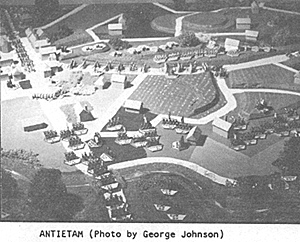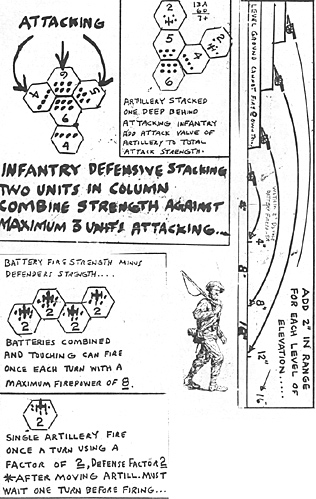 How many wargamers would like to be able to introduct their friends to this fascinating hobby, but are stifled by set up time and space requirements needed for 15mm to 30mm scales. Historical wargaming in 5mm micro scale allows the gamer the luxary of permanent battlefields that are easy to store and ready for combat on short notice.
How many wargamers would like to be able to introduct their friends to this fascinating hobby, but are stifled by set up time and space requirements needed for 15mm to 30mm scales. Historical wargaming in 5mm micro scale allows the gamer the luxary of permanent battlefields that are easy to store and ready for combat on short notice.
Getting started in the hobby through Avalon Hill's GETTYSBURG game soon graduated to armies in 15mm to 25mm which now cover the American Revolution, ACW, and British Colonials. When I decided to create downscale versions of Antietam and Stones River battlefields I turned to 5mm, scratch building both scenarios. Returning to the basic GETTYSBURG rules I mounted the troops on 5/8's" hexagon unit stands. Transposing the maps found in the THE WESTPOINT ATLAS OF AMERICAN WARS onto a sheet of artboard, I was under way. Anyone with a little artistic ability can use the following instructions and materials to create satisfactory game boards for whatever period they are interested in.
MAPBOARD:
Transfer and enlarge to scale the map of the battlefield onto a sheet of white artboard (standard size is 30" X 40"). Glue the artboard to a sheet of 1/4" plywood or tempered masonite; this adds rigidity to the board and will keep it from warping. Now draw in the roads, rail lines, rivers, towns and major elevations. Make paper templates on the elevated sections and then use the templates to cut them from sheets of foam core art board in 1/8" to 1/4" thicknesses. When cutting out these sections taper the edges to simulate the natural slope of hillsides. Glue the raised sections in place with woodworker's glue.
Painting the board (I prefer using artist's acrylics) begins with filling in the larger areas, fields and forests, and then adding the streams and roads. The fields are done in light greens, plowed fields in dark brown, forests are dark green with a mottled effect that is obtained by taking a piece of wet sponge dipped in light green and stipling over the darker base color. Roadways are done in light gray or tan to highlight them. Roads should be at least 5/8's" wide in open areas and one inch wide through towns.
Rivers and streams are laid in with shades of dark blue which can be overcoated with a high gloss varnish. Rail lines are tacked in place using "N" gauge track or "Z" gauge when available. The "N" gauge cork roadbed can be cut to form stone bridges with sides, railroad grade crossings and stonewalls which are made by cutting thin strips from the tapered edge of the roadbed material. Buildings are scratch built, using balsa wood stock and thin pieces of hardwood for chimneys.
Antietam (Photo by George Johnson)
Porches can be added to houses by using thin plastic sheeting and wood pillars. Assemble the buildings in towns, leave the streets at least one inch wide to allow for easy passage of troops. The final scenic touches are made by adding model railroad grass and soil over areas where wood-glue thinned with water has been applied. I also ad pieces of "Woodland Scenics Foliage" to areas where I want to show heavy underbrush. The outer edges of wooded areas are enhanced by adding lichen moss and "N" gauge pine trees. Small round clumps of lichen are cut flat on one side and then glued in place using Weldwood "Touch-N-Glue", giving the appearance of hardwood trees.
TROOP MARKERS:
Unit stands are cut from .030 sheet plastic in either 5/8" hexagons or areas. Score the sheet plastic with a Stanley razor knife and the pieces will snap off easily. Before snapping off the individual pieces, I spray paint the sheets of stands in colors that will designate the opposing sides clearly. For the ACW games, I used Heroics & Ros figures mounted on the stands with "Touch-NGlue". Prior to mounting the figures they are spray painted in gray or blue and the detail colors are brushed in. They are then cut from the strips they come in and are applied to the stands. I handpainted the flags, but you can use 15mm paper flags trimmed down and glued over the flags on the stands. For infantry I use a unit strength system based on the number of figures on each stand. Attached to the back half of the stand is a piece of plastic tape with the unit's information printed on it. Cavalry units have their unit strengths marked on them.
Stone's River Strength Points
US: 358 -- Inf 276, Cav 33, Art 48
CSA: 331 -- Inf 234, Cav 51, Art 46
Sequence of Play:
1. Cannon fire (both sides)
2. Retreating units move (both)
3. CSA advance & Combat
4. US advance & Combat
| MOVEMENT CHART | |||
|---|---|---|---|
| Unit | On Road | Off Road | Retreating |
| Infantry | 3" | 2" | 1.5" |
| Cavalry | 8" | 4" | 3" |
| Artillery | 3" | 2" | 1" |
| Commandser | 8" | 6" | 4" |
| Messenger | 10" | 8" | - |

- AR: The attacker retreats all of his attacking units involved in the attack one or two hexes and in any direction of his choice. The route must not contain a hex which is adjacent to an enemy unit or violates stacking restrictions or is off the board. If there is no route available, the retreating unit is eliminated instead.
DR: Same as AR except the defender retreats all defending units involved in attack.
AE: All attacking units involved in the attack are eliminated. DE: All defending units involved in the attack are eliminated.
EXC: Both sides eliminate one unit of their choice involved in the attack.
C: No result. Both sides remain in contact. The defender in his turn has the option to counter-attack or disengage(move away).

Back to MWAN # 20 Table of Contents
Back to MWAN List of Issues
Back to MagWeb Magazine List
© Copyright 1986 Hal Thinglum
This article appears in MagWeb.com (Magazine Web) on the Internet World Wide Web.
Other articles from military history and related magazines are available at http://www.magweb.com